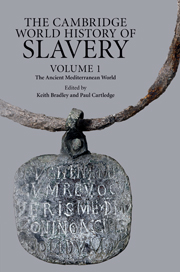Book contents
- Frontmatter
- Contents
- Series editors' introduction
- List of figures
- Acknowledgements
- Introduction
- 1 Slavery in the ancient Near East
- 2 Slaves in Greek literary culture
- 3 Classical Athens
- 4 The Helots: a contemporary review
- 5 Slavery and economy in the Greek world
- 6 The slave supply in classical Greece
- 7 Slavery and the Greek family
- 8 Resistance among chattel slaves in the classical Greek world
- 9 Archaeology and Greek slavery
- 10 Slavery in the Hellenistic world
- 11 Slavery and Roman literary culture
- 12 Slavery in the Roman Republic
- 13 Slavery Under the Principate
- 14 The Roman slave supply
- 15 Slave labour and Roman society
- 16 Slavery and the Roman family
- 17 Resisting slavery at Rome
- 18 Slavery and Roman material culture
- 19 Slavery and Roman law
- 20 Slavery and the Jews
- 21 Slavery and the rise of Christianity
- 22 Slavery in the late Roman world
- Bibliography
- General index
- Index of ancient passages cited
- Index of inscriptions and papyri
- Index of Jewish and Christian Literature Cited
16 - Slavery and the Roman family
Published online by Cambridge University Press: 28 September 2011
- Frontmatter
- Contents
- Series editors' introduction
- List of figures
- Acknowledgements
- Introduction
- 1 Slavery in the ancient Near East
- 2 Slaves in Greek literary culture
- 3 Classical Athens
- 4 The Helots: a contemporary review
- 5 Slavery and economy in the Greek world
- 6 The slave supply in classical Greece
- 7 Slavery and the Greek family
- 8 Resistance among chattel slaves in the classical Greek world
- 9 Archaeology and Greek slavery
- 10 Slavery in the Hellenistic world
- 11 Slavery and Roman literary culture
- 12 Slavery in the Roman Republic
- 13 Slavery Under the Principate
- 14 The Roman slave supply
- 15 Slave labour and Roman society
- 16 Slavery and the Roman family
- 17 Resisting slavery at Rome
- 18 Slavery and Roman material culture
- 19 Slavery and Roman law
- 20 Slavery and the Jews
- 21 Slavery and the rise of Christianity
- 22 Slavery in the late Roman world
- Bibliography
- General index
- Index of ancient passages cited
- Index of inscriptions and papyri
- Index of Jewish and Christian Literature Cited
Summary
FAMILIES AND FAMILIAE IN ROME
In the early first century ad as one left the centre of Rome along the via Labicana heading south-east in the general direction of Praeneste (modern Palestrina), one would pass by the vast suburban estate of the Statilii Tauri, a distinguished senatorial family. These Horti Tauriani (‘Taurian Gardens’) had been developed by one of Augustus' most trusted generals, T. Statilius Taurus, consul in 37 bc and again in 26 bc. They eventually attracted the avaricious attention of the younger Agrippina, wife (and niece) of the emperor Claudius, and when in ad 53 T. Statilius Taurus (consul in ad 44) committed suicide after being charged with treason, the property passed into imperial hands. The marriage of Statilia Messallina, niece of the consul of 44, to Nero in 66 rehabilitated the family, who regained control of their luxury gardens, but this was to be short-lived; for once Messallina's marriage came to an end with Nero's suicide in 68, the estate reverted irrevocably to the imperial fisc. In the far south-east corner of these horti, near to where the Porta Maggiore now stands, the family constructed under Augustus or Tiberius a large funerary monument to house the remains of the many slaves and freed slaves who had been owned by the various members of the gens Statilia. During the family's political renaissance under Nero, further chambers were added.
- Type
- Chapter
- Information
- The Cambridge World History of Slavery , pp. 337 - 361Publisher: Cambridge University PressPrint publication year: 2011
- 14
- Cited by



